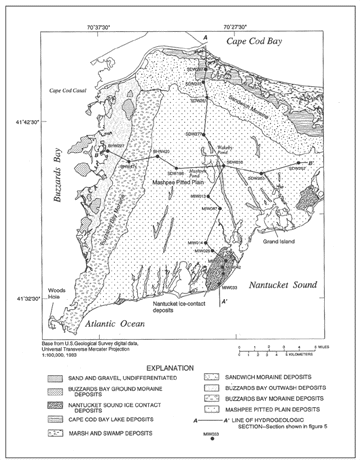 |


|
Purpose
In this activity, students will use different kinds of geologic information to predict the path of ground-water contamination from several toxic waste sources on the Massachusetts Military Reservation (MMR). Once they have drawn possible plume paths, students will receive the actual contaminant plume traces for comparison.
Materials
Each group of students will need:
- map of MMR and water table configuration on March 23-25, 1993,
- map of surficial geology of area with location of hydrogeologic sections and explanation,
- figure showing hydrogeologic sections with explanations,
- map showing contaminant plumes at MMR,
- tracing paper, and
- colored pencils.
Procedure
- Begin by defining the water table for the students. Explain that about half of the water that falls on the Cape Cod landscape - in the form of rain - or snow - percolates into the ground. It gathers in the saturated zone, where all the pores and crevices of the rock and soil are filled with water. The top of this zone is the water table. If one were to dig a well that just penetrates the top of the saturated zone, the water table would be the level at which water stands in the well.
- Provide students with copies of the water-table map. As a class, have them identify the highest elevation of the water table and the lowest elevation. Explain that the contours on the map indicate the surface of the aquifer, or the water table.
- Ask students what direction(s) they think water is moving in the aquifer. (Water moves down the water-table slope in the aquifer. The MMR sits atop a round hill at the highest point of the water table.) To answer this question, ask them to remember how water moved in their model aquifers in Activities 1 and 2.
- Now have students look at the hydrogeologic map and the sections. Explain that the sections are vertical slices that represent the distribution of rocks and sediments underlying the surface. These sections were constructed using materials brought to the surface during well drilling.
- When you are confident students understand the information provided by the geologic map and sections, ask them to predict what kind of materials make up the aquifer in this region. To make this prediction, students can refer to the sections.
- Have students locate the four major contamination sites on the water-table map. Then, ask them to use the water-table contour map and the geologic information to predict the path of contamination movement. Remind the students to think about the kinds of sediments and rocks that are likely to be permeable and that are likely to be impermeable.
- Have students place the tracing paper on top of the water-table contour map. Then have them sketch the paths they predict the contamination will take on the tracing paper.
- When students have finished drawing what they believe will be the path of contamination movement on the tracing paper, have them show each other what they drew. Ask students to explain why they believe the contamination will follow the path they drew.
- Distribute the map that shows the plumes. Have students compare the contamination paths they drew to the actual plumes. Point out that these maps were developed by geologists who sank a large number of test wells into the aquifer to measure the contamination levels in the ground water. Lead students in a discussion of how their predictions could have been used by geologists trying to decide where to put their initial test wells.
Extension
Since 1973, the MMR has been used primarily by the Massachusetts National Guard and the U.S. Coast Guard. In 1986, the National Guard Bureau's Installation Restoration Program (IRP) began investigating the contaminant plumes related to hazardous materials at the MMR. Since 1994, the IRP has published fact sheets that describe the history, size, and risks caused by each plume and what the IRP proposes to do about it. Call the IRP office at (508) 968-4678 to request copies of the 11 fact sheets published in 1994 and any others published since that time. Distribute copies of the IRP's Plume Response Fact Sheets to students as they answer these extension questions.
- Are any of the local ponds in danger of contamination?
- Are any of the town water supplies in danger of contamination?
- How can the movement of the contaminant plumes be slowed?
- Where would students put in wells to remove contamination?
- How else could the contaminated ground water be cleaned up?
- Where would it be safe to drill wells for drinking water?
Note: In 1996, the U.S. Air Force's Center for Environmental Excellence assumed responsibility for containment, cleanup, and remediation of contaminated ground water within and emanating beyond the boundaries of the MMR.
 |
| Firewater: a ground-water sample from one site on the MMR contained enough jet fuel to burn. |
 |
| Location of Massachusetts Military Reservation and water-table configuration on March 23-25, 1993 (Masterson and others, 1996) |
 |
| Surficial geology and lines of hydrogeolocgic sections, western Cape Cod, Massachusetts (Masterson and others, 1996) |
 |
| Hydrogeologic sections A-A' and B-B' showing glacial drift of western Cape Cod, Massachusetts (Masterson and others, 1996) |
 |
| (Masterson and others, 1996). |
|
Teaching Guide |
Student Guide |
Download PDF
|
|
|
 |
|